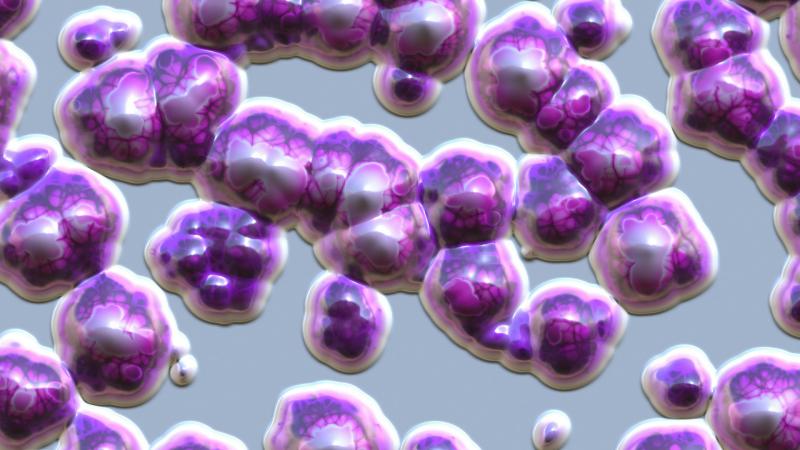
Cancer is a condition where cells in our body go rogue, multiply rapidly, defy death and disobey space and nutrient constraints. But how do cancerous cells derive the extra nutrition necessary to grow and reproduce quickly? It turns out that, they coerce the healthy cells by rewiring the metabolic networks of these cells. Now, a new study by researchers at the Indian Institute of Science Education and Research (IISER), Bhopal, has revealed an intricate molecular relationship scripted by cancerous cells to alter the healthy metabolism of healthy cells.
In the study, the researchers have unearthed a nexus of three cellular processes--the Warburg effect, alternative splicing and epigenetics-- employed by cancerous cells to devour the required nutrition to quench the ever-growing thirst for more resources. The research is published in the journal Proceedings of the National Academy of Sciences of the United States of America (PNAS) and funded by the Science and Engineering Research Board (SERB) and the Wellcome Trust/ Department of Biotechnology (DBT) India Alliance.
The first process called the ‘Warburg effect’, is an alternative mechanism of glucose metabolism seen in cancerous cells. Typically, in a healthy cell, glucose from the food is oxidised to produce Adenosine triphosphate (ATP) molecules that fuel all the processes inside the cell. Since cancerous cells have a humongous appetite for rapid energy production from glucose they employ fermentation of glucose, something that happens in our muscle cells when they are working full steam. Cancer cells re-engineer the glucose metabolic network to convert glucose into lactate to meet the energy demand.
The second process, called ‘alternative splicing’, is a genetic mechanism that impairs the genetic sequence in some instances. The DNA of all higher organisms are interrupted by non-coding chunks called introns, which do not contain any information about producing a protein. These introns are located between exons—fragments which carry information for the protein. The pre-mRNA, which helps to copy the protein recipe from the DNA, contains both introns and exons. In a process called splicing, the introns in the pre-mRNA are removed, and the exons are joined. However, in the case of alternate splicing, one or more exons are either retained or deleted to add or delete sequence information for the protein, resulting in the production of two different proteins from a single gene under different circumstances.
The third piece of the puzzle is epigenetics- heritable changes in gene function that do not involve changes in the DNA sequence. Individual genes can either be switched ‘on’ or ‘off’ by tagging small methyl groups on the DNA in which the genes reside. The addition of such methyl groups control gene expression. Some cancerous cells exploit this mechanism to selectively turn on the genes that rewire the metabolic activities of the cell.
The researchers of the study have discovered how cancerous cells induce the Warburg effect by studying many molecular interactions of the breast cancer cells. “For the first time, we have provided a functional link between epigenetics, alternative splicing, Warburg effect and growth of breast cancer cells,” says Prof. Sanjeev Shukla from IISER, Bhopal, who is an author of the study.
The researchers found out that a specific pyruvate kinase gene (PKM) contains two mutually exclusive alternative exons called exon 9 and exon 10. The version of the mRNA that contains exon 9 produces the PKM1 transcript, which is involved in the normal glucose metabolism. However, in breast cancer cells, exon 9 is replaced by exon 10 through alternative splicing to produce the PKM2 transcript. This gene assists in the conversion of glucose into lactate, bringing about the Warburg effect.
The first finding of the study was that exon 10 of the PKM gene in breast cancer cells, responsible for inducing the Warburg effect, was heavily methylated. The methylated exon 10 attracts a protein called BORIS (Brother of Regulator of Imprinted Sites), which is again an aberrantly expressed protein in breast cancer cells. The presence of BORIS on exon 10 enriches the enzyme called RNA polymerase II, which is involved in copying the DNA to mRNA. Once RNA polymerase II accumulates near exon 10, the protein complex needed for splicing this gene also gets gathered near exon 10 and results in the addition of exon 10 into the final mRNA. Hence, exon 10 is preferentially spliced into the PKM2 transcript that sets off the Warburg effect.
The researchers also studied the process through the genome editing tool called CRISPR. They unfolded a sequence of significant interactions in cancerous cells, which can improve our understanding of the molecular basis of the disease.
The researchers have also shown that if some molecular tools inhibit important proteins like BORIS, the Warburg effect reverses in cultured cancer cells. This finding is exciting since it could provide new molecular targets for the development of anti-cancer drugs. If any of these drugs work on cultured cancer cells, they may potentially be developed further to work in human patients, say the researchers.
“Though this will be the subject of future investigations using animal models, the DNA methylation inhibitors are already approved for some blood malignancies and are under active investigation for solid tumours but the exact mechanism by which these drugs work is not clear”, signs off Prof Shukla, raising hopes of possible new drugs against cancer.






